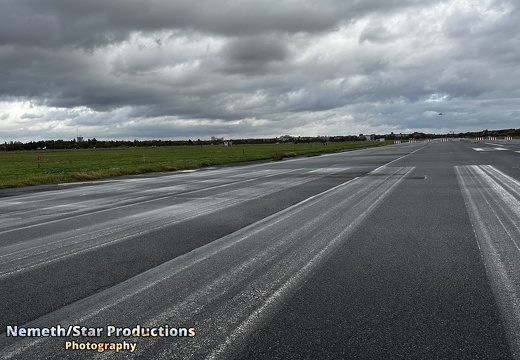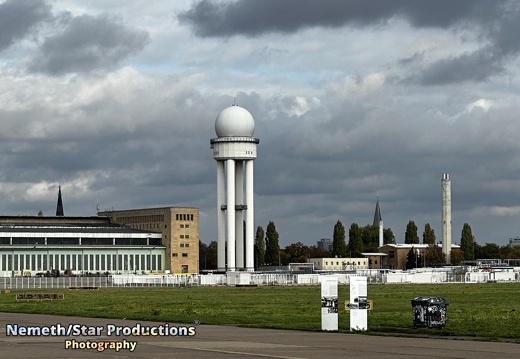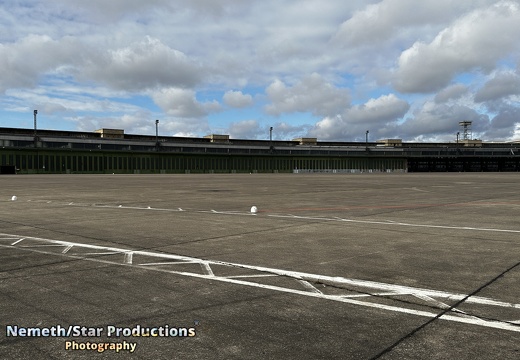Nemeth/Star Productions - Picture Gallery









Legal Notice
Privacy
© Nemeth/Star Productions 2025
Once Tempelhof Field was no longer needed for troop exercises, the Prussian Military Exchequer sold the western part of the complex to the Tempelhof municipality for what was ividely criticised as an exorbitant price. There were also debates about whether it should become the site of a densely built residential area. Even back then, the wide expanse was regarded as “One of Berlin’s last sets of lungs”. Nevertheless, two residential and commercial buildings were constructed in 1912/13 to plans in historicist style by the, architect, Bruno Möhring as a gateway to the planned district alongside the Kaiserkorso street. After the Kaiser’s reign came to an end, the Weimar Republic made it possible to realise advanced forms of public housing on a larger scale. This allowed for the construction of a “garden city” here, instead of the planned tenement housing. In the years 1920 to 1928, as an alternative to the otherwise densely constructed big cities, a more open style of development based on the English model flourished here, with public parks, vegetable gardens and community facilities for “like-minded people”. The plans for the garden city were drawn up by the architect and city planning councillor, Fritz Bräuning. Using a curved street plan already designed in 1911 by Friedrich Gerlach, he created an urban complex with a broad park belt, meadows with artificial paddling pools, public squares and mainly two-storey terraced and individual houses surrounded by five-storey apartment blocks. The settlement earned much praise from contemporary architecture critics. The naming of most of the streets in 1936 after “pilot heroes” from the First World War can be attributed to the National Socialists. The distriet is still commonly referred to as the Fliegerviertel (pilots’ quarter). Despite some changes in the postwar era, the basic structure of the garden city remains intact. THE GROUND CREW On the sandy and open spaces of the former airfield we find the ground crew, beetles, spiders and grasshoppers. Ground beetles are amond the beetle species occurring here most frequently. 68 spices have heen identified here. There are hunters that are active on day such as the tiger beetle and nocturnal species e.o. the shiny oreen beetie, a spider species have been identified at the Tempelhof Field, including numerous endangered species. The species include pure herbivores, e.g. the blue-winged grass-hopper. The green bush-cricket and the wart-biter, however, feed on insects. THE PLANT LIFE OF THE PARK The meadows at Tempelhof Park range primarily from dry sandy grassland to fresh oat-grass meadows. The soil of the dry grassland is very sandy and deficient in nutrients. Dwarf everlast, field sagewort and maiden pink grow here. Ameria and hoary alyssum are also typical. Expansive meadows that are not fertilised or intensively cultivated have become rare in today’s Central European cultural landscape. For this reason alone the 'meadow sea of the Tempelhof Park is something very special. On 1 May 1933, one of the first and - with approximately one million participants - biggest mass parades during the Nazi period was held on Tempelhof Field. The regime had previously ideologically reinterpreted 1 May (since 1889 the day of the international workers movement) and declared it the “Dav of National Labour”. It was now supposed to serve the purpose of propagandistically staging the National Socialist “Volk community”. From the morning on columns of marching Berlin workers, who were compelled to gather in their enterprises, as well as formations of the SA, the SS and the Reichswehr marched to lembeinor rield. The ominprescent flags and uniforms, the march and choral music, the torches and lambs as well as spectacles - such as air displays - were typical of National socialist mass rallies and meetings. The highlight was the rally, which started at nightfall with a speech by Hitler. Albert Speer, who later became Hitler’s most important architect, designed a vast tribune for the Nazi leadership and the various National Socialist organisations. The mass event, organised by Propaganda Minister Joseph Goebbels, was the propagandist prelude to the following act of violence, which had been planned well in advance: On 2 May, the trade unions premisses were occupied and leading functionaries arrested and maltreated. Some of them were murdered. The Nazi regime destroyed the unions and integrated their members into the “German Labour Front”, which was founded only a few days later. The first parade staged by the Berlin garrison on Tempelhof Field was arranged by the ‘Soldier King’, Friedrich Wilhelm I in 1722. At their annual marches and manoeuvres, the regiments exercised in the presence of the monarch in order to demonstrate the skills they hac acquired during the course of the year. The owners of the site were Tempelhof farmers. The army compensated them for damages to their farming land and their pastures. When. however, the area was used almost every day for military exercises following the reform of the Prussian army in 1807, protests occurred again and again. In the end, the military authorities bought Tempelhof Field instalment-wise, from 1826 on, as a drill ground for the Berlin garrison. After the victory over France and the founding of the German Reich in 1871, the parades held on Tempelhof Field became particularly splendid in an effort to demonstrate the German Empire’s claims to power and its representational ambitions. At the same time the army was modernised: Railway troops and an airship crew division were stationed on the edge of the field from 1883 on. Towards the end of the 19th century, two mighty barracks complexes were constructed in the north to accommodate the Königin Augusta Garde Grenadier Regiment No. 4 and the Guard Cuirassier Regiment. A military prison was also built here which would be used as a concentration camp during the National Socialist period. The characteristic feature of the airport’s architecture is its prestigious monumentality and technical modernity. The natural-stone cladding, the strict arrangement of the windows, the seemingly fortified towers. On the aerodrome side, one is struck by the modern, pure steel structure ot the hangars with its distinct curvature. In the middle, the 380 metres long boarding gate is supported by a technically very sophisticated, cantilevered load-bearing Structure. The engineer Arno Schleusner was responsible for the structural design. The logistics planning was state of the art. It allowed to the separation of different traffic-flow categories: passengers, freight and mail and their distribution at various levels. The ambivalence of a modern Structure and access system, on the one hand, and monumental appearance, on the other is typical or monumental Nazi buildines. The airport building was meant to have had a lavish artistic design. It was, however, executed in part only. Walter E. Lemcke, the sculptor, created the martialistic sculpture of an eagle on a stope showing a massive swastika, which crowned the root of the reception building. On the facades of the building at the Rundplatz, Lemcke also designed agressive-looking eagle relies in keeping with the times. The Construction and the Overall Complex Tempelhof Airport, which was built as a “World Airport” under National Socialist rule, was conceived as a demonstration of the regime’s power, while simultaneously fulfilling all the requirements of a modern traffic centre. By the early 1930s, the previous airport had already reached full capacity. After the National Socialists came to power. Hitler ordered the construction of a new airport, its dual use as a military and civilian airport, and the establishment of an urban link to the North-South axis as part of the new planning concept for Berlin. In 1935, the architect Ernst Sagebiel was commissioned to build the airport. The client was the Reich Ministry of Aviation. The complex is composed of an ellipse created by the aerodrome and the vast building complex extending along its north-western vertex. It consists of a series of symmetrical sections, starting with a large circular square (only partly completed) that opens into a "Court of Honour" flanked by administration wings. This court, in turn, leads to the reception building and the terminal building. Construction, which began in 1936, ceased during the Second World War. The stair towers, for instance, remained unfinished. They were designed as ascents to the planned roof tribune, which was scheduled to hold more than 80,000 spectators at the Luftwaffe air displays projected by Hitler. During the war, the new building ensemble contained production centre for the armaments industry, as well as a commandant's office. Near the entrance to the departure building is a statue of an eagle's head. According to the inscription on the base, this is all that remains of the 4.5 m statue of an eagle, designed by Sagebiel and executed by the sculptor Walter Lemcke, which stood on the roof of the building and was visible from a considerable distance. Contrary to the assumptions of many, it grasped in its claws, not a swastika (like the eagle which symbolized the Third Reich), but a globe (like the planned summit of the Great Hall designed for Germania. In 1962 it was removed to permit the installation of new radar equipment and sent to the museum at the United States Military Academy at West Point. The U.S. Air Force returned it to the people of Berlin in 1985. Text Source: City of Berlin and Wikipedia
Powered by Piwigo





























